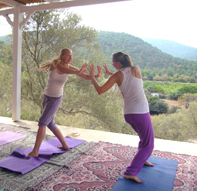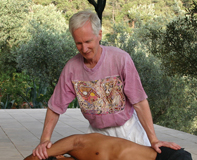

These are all ways to appreciate and flow with the Lifeforce rather than struggle against it. Another way to say this is that Ki, vital energy, is the key, and Hara in its wide interpretation as ‘the vital centre of man’ described by Graf Dürckheim is the unifying point where Ki can be concentrated and developed. They are major parameters of my life and I’m constantly studying the way they interweave and what they add up to.
‘Hara’ or ‘Tanden’ is the centre of your vital energy. It can be considered to be your whole abdomen or it can be taken as a point slightly below the navel and in the centre of your body, somewhat equivalent to the Manipura Chakra. When movement is generated from your centre you can express yourself with dynamic power while remaining completely relaxed. By keeping attention at that point your posture remains stable and solid, your mind and body become coordinated so that you are calmly responsive to the stresses of life. With this stability the lungs can open, the heart can more easily and generously extend to other people. Flexibility and power come through concentration and trust instead of becoming tense in your shoulders, stiff and flustered as Ki rushes to your head in a moment of stress and you try to control the world with your limited personal strength.
Indian yoga has many exercises to open and strengthen the lower body through the legs, hips and core muscles, and if you think Master Oki was a tough task-master there are plenty of highly demanding teachers in the Indian tradition and what the West has made of it. Try a class with Ana Forrest for instance! Once you have stood in Warrior 2 pose for 5 minutes and followed that with her core exercises you will know your lower body’s capacity very well.

Master Oki considered the further dimensions of Indian yoga to be gymnastics and unnecessary for the everyday tasks of Karma Yoga, serving other people, working for the happiness of all. Nor are they necessary beyond the point where your body is relaxed and open enough to sit peacefully for Dhyana (Zen) meditation practice.
In Okido Yoga the Kyoka-Ho discipline may also seem wild and gymnastic at times, but the purpose is to translate the power of Hara into joyful action. Pulling, pushing and lifting for instance are everyday actions, but how often do people do these things from their arms and shoulders only?
Unless the posture of the whole body is aligned and the pelvis in particular is engaged at the correct angle, the power is limited and the risk of injury great, leading to pain, suffering and eventual death! No joyful action there.

A second purpose of Kyoka-Ho is to develop the confidence that you can stay calm and centred when faced with a challenge. This might be a physical or practical challenge, in which case you give your best while also being able to assess what is possible and what is foolhardy. The challenge could also be emotional or mental, in which case the capacity to stay ‘in your Hara’ means that you won’t be overwhelmed by panic, anger, confusion or any of the other myriad waves of turbulence.
Similar lessons come from Aikido. The context is different but it is not as if we are really training to face multiple attackers even if that’s what happens in the black belt gradings. Sensei Williams (in English we put the ‘Mr’, or whatever, before the surname, not after as in Japanese, so this is how we refer to him), who is head of the Ki Federation in England, describes Aikido as ‘exercises for coordination of mind and body’. Obviously, being attacked by several people at once is the simulation of a high stress situation, but whatever happens the real test is to stay calm and centred, not clashing with the swirling energies. In Aikido the person executing the techniques never attacks. He or she blends with the other energy and diverts it, neutralizes it. One instruction is to you ‘put yourself in your partner’s place’. And if something goes wrong you follow the Ki in such a way as to stay coordinated and safe. As soon as you become stiff and muscular you become vulnerable to injury, pain, suffering and . . .
From the very beginning of training one has the experience that just to focus your attention in your Hara brings a stability that is absent if your mind is wandering. The same is true if you adopt a good, light posture, relaxed, not tense, or slouching. Seemingly so simple, yet our habit is to counter physical and even emotional difficulties with hardness (as long as we don’t just collapse!), to want to grasp and control. This is the way to exhaust your personal energy quickly. The alternative is to ‘extend your mind’, another Aikido instruction which means to see yourself as a manifestation of the Lifeforce of the whole universe.
This way, for instance, your arm becomes unbendable though you make no effort yourself. It’s easy to demonstrate. Keeping some small percentage of your attention in your Hara, many things become effortless which previously were a struggle!
In different ways, Aikido and Okido teach how to stay relaxed and open and how to appreciate, adapt and move with the energies of the universal Lifeforce so that it flows in and through us uninhibited.
Zen teaches how to stay peaceful amidst the turbulence of the inner world. It also teaches how foolish it is to try to control people and circumstances rather than looking deeply and realizing that no one and nothing is separate from everything else, that we are all creating the same reality together in our different ways.

After all this, the place and practice of shiatsu is easy to understand. It takes its place in Okido Yoga as an expression of Karma Yoga, service to others and the desire to relieve pain, suffering, and avoid the further consequence as long as possible. The practice starts from the heart and the Ki follows, embracing your partner. If you extend your mind to your partner’s whole body, and with it your Ki, your practice is deep, gentle and effective, whereas if you work only from your hands and imagine only the surface of the body, the feeling will be hard and superficial. Once again your energy and your movement come from your Hara. If not it will become hard work and exhausting as well as ineffectual. Zen shiatsu is a practice of responding through your own stillness and deep listening to the area of your partner that needs most support.
The continued study of these strands (and a few others), the weaving of them and the sharing of the result are now my life’s practice. Why? So that everyone, including myself, may be happy and free!
Michael’s first intense experience of Okido yoga was in 1989 and he has been a constant devotee since then. He organizes ‘Health and Yoga Holidays’ in Turkey with his partnet, Pervin, has a black belt in Ki Aikido, and is a shiatsu practitioner and teacher in London.
The book ‘Hara: The Vital Center of Man’ by Karlfried Graf Dürckheim (1898-1988) was originally published in Germany in 1956. The English translation is ISBN 978-1-59477-024-1
© 2025 Okido Natural Health Education Trust CIO
Charity Registration No: 326669 (England & Wales)